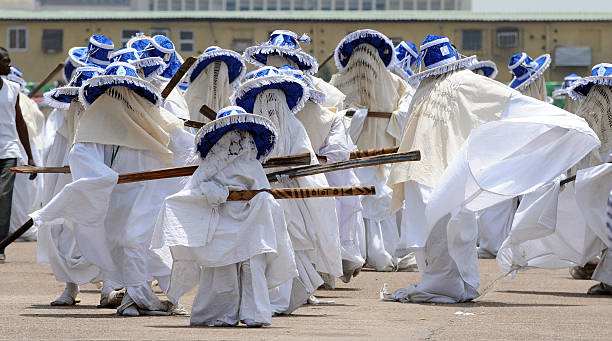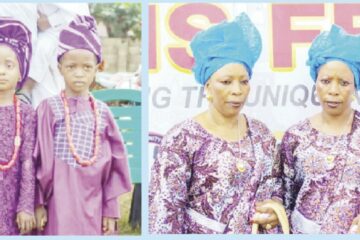The Eyo Festival, also known as the Adamu Orisha Play, is a Nigerian festival unique to the people of Lagos State. The Eyo festival is organised under the auspices of the Yoruba tradition, as well as social organisations or clubs. It is an outlet used to showcase the culture of the Isale Eko people.
The 24 days festival features a major parade with participants dressed in white flowing robes that cover their entire body, top hats and sticks, and masquerades referred to as “Eyo” as well as costumed dancers. The festival sweeps through the entire city with a focus on Lagos Island and attracts a large number of tourists from around the world.
In modern times, it is presented by the people of Lagos as a tourist event and, due to its history, is traditionally performed on Lagos Island.
The Eyo is believed to represent the spirits of the ancestors. The Eyo festival may be held in honour of a chief or an elder of a ruling family or an Oba, who had died. It may also be held when a new head of an Iga (palace) or a new Oba is installed.
With the advent of westernization and modernization, a governor or a political leader may also request that the festival be organised to add colour to an occasion for a fee. Eyo is usually held on a Saturday.
Each Eyo comes out of an Iga (palace) of a ruling family in the morning and heads for the shrine (Agodo). It is robed from head to toe in white flowing cloth. The white flowing costume consists of an ‘agbada’ (the top robe), and the ‘aropale’ (the bottom wrap around). No part of the person carrying the Eyo is expected to be seen.
The Eyo also wears an ‘Akete’ hat that bears the colours and shield of the Iga from which he comes. An Eyo may tie ribbons in his Iga’s colours to the Opambata (palm branch) that he carries. An Iga’s Eyo may have up to 50 to 100 or more members. Each person carrying a robe as Eyo must pay a fee for the privilege. This fee is paid to the Iga – ruling house, whose colours and Akete the Eyo wears.
Only adult males may robe as Eyo; but sometimes, there may be a child Eyo in a group. The sons and daughters and wives, as well as friends and neighbours of the Iga follow the Eyo on a parade from one end of Lagos Island to the other.
The route of each Eyo goes from the Iga, where the Iga’s Eyo leave en masse, and then on to the Agodo – the shrine of the Orisa Eyo. After this, the Eyo may go anywhere on Lagos Island their feet can carry them, all the way from Ebute Ero to Obalende, via Oke Popo, Campus, Lafiaji and all neighbourhoods the Eyo’s whims may carry him. In fact, an Eyo may easily cover 20 to 30 kilometres on that day.
The only Eyo that is not part of a group is the most senior Eyo-Adimu Orisa. This Eyo’s nose is forever running, hence the name Adimu. Only a very old and spiritually advanced male can robe as the Adimu. It is the last Eyo to leave the “agodo.”
The Eyo, when it encounters people, greets them with the phrase, “E sunrunkunrun, we ma jagbon die!” meaning, “Don’t fear anything, have a taste of the palm tree,” and taps the individual on the shoulders with the “opambata.”
When he is given money, he will pray for the person and recite the praise song of his Iga. The phrase, “e sunrunkunrun, we ma jagbon die!” is in the Ijebu dialect of Yoruba. It was rendered as a wedding present when the Oba of Lagos married an Ijebu princess.
It is, however, a taboo to either wear the Eyo costume overnight or cross any body of water, such as the lagoon, rivers and so on.






